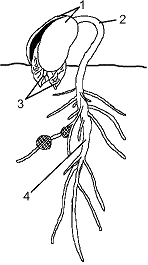The process illustrated in the accompanying figure is:

a. imbibition.
b. germination in a monocot.
c. apomixis.
d. abscission.
e. germination in a eudicot.
e
You might also like to view...
Melanin absorbs UV radiation and can therefore protect against some forms of skin cancer. Which type of cells produce melanin?
A. melanocytes B. chondrocytes C. actinocytes D. lymphocytes E. osteocytes
A group of similar, interbreeding individuals that live in the same area is a(n) ________
Fill in the blank(s) with correct word
The ____ belongs to the same protostome clade as mollusks and annelids.
A. Cnidaria B. Platyhelminthes C. Crustacea D. Arthropoda E. Nematoda
When bacteria are inoculated into a new sterile nutrient broth, their numbers don't begin to increase immediately. Instead, there is a lag phase that may last for an hour or even several days. Why don't bacterial numbers increase immediately?
a. There are not enough nutrients for the bacteria to grow, and growth is delayed until there are some dead cells to cannibalize. b. The bacteria have to establish a biofilm before their numbers can increase. c. The bacteria must adjust to the nutrient content in the new medium, synthesizing necessary amino acids, growth factors, and enzymes. d. The medium contains inhibitors that prohibit rapid growth of the bacteria, and these must be inactivated before bacterial numbers will increase.